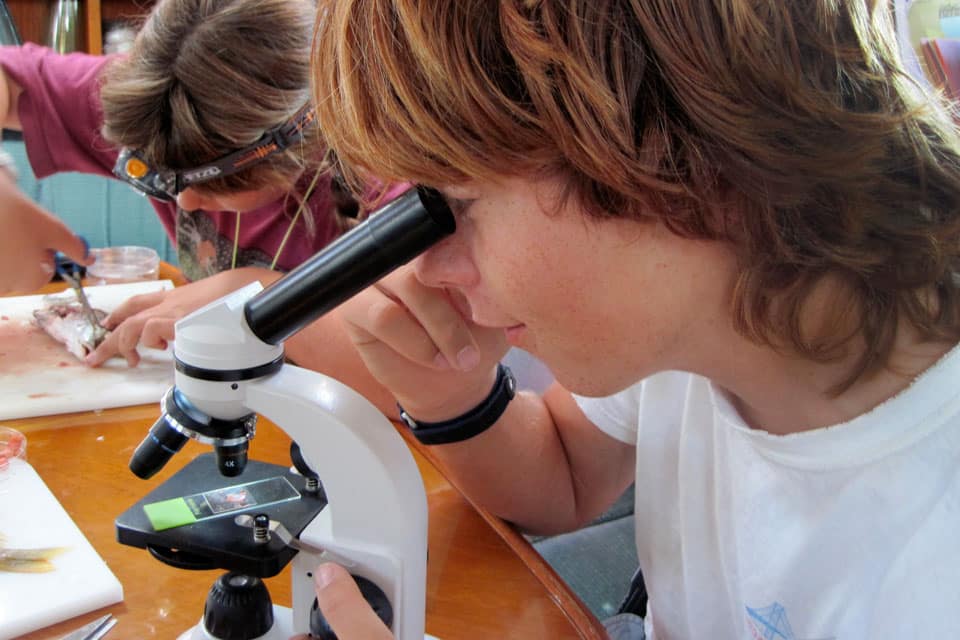
Onboard science lessons
“We have a nice schoolmaster snapper here, and a sailor’s choice,” our friend Betsy Davenport said, laying the two recently deceased fish on cutting boards and spreading an array of tools—scissors, knives, picks, a microscope, slides—across the nicely varnished table. She was just finishing up making cinnamon rolls, and the warm, homey scent from the oven mingling with that of dead fish imbued the cabin with a certain_ je ne sais quoi._
Betsy is a former high-school biology teacher. Her husband, Sam, and their three sons had contributed to the biology lesson by spearing said fish. Sam was on a six-month leave from his law firm, and Chere was the vehicle for their short-term cruising dreams.
“So what I’ve found works well is to go in here, under this bony plate, called the operculum,” Betsy said. She pushed the tip of a small pair of scissors into the side of the schoolmaster and started digging around, her explorations making a gristly sound. As my daughter Kailani dove right in on the sailor’s choice with another set of scissors, my son Kaeo took cover behind the microscope. “I already did this, you know,” he grumbled. “I dissected a frog in microscope class. It was disgusting.”
That’s where I, as the mom/teacher, might have said something like “Well, tough. You’re gonna do it again.” But I wasn’t teaching this class; Betsy was. The only emotional or professional investment she had in Kaeo was in piquing his curiosity, and so she said cheerfully, “OK. I’ll work on your fish for now.” And so Betsy and Kailani picked and cut and prodded, identifying and tweezing out organs and exclaiming over their finds. It wasn’t long before Kaeo was bent over the table, too. When Betsy found a bulging egg sac in one of the fish, she cut a sliver and prepared it on a slide, showing the kids her technique for drawing the excess water and dye away from the specimen. Then she handed it over to Kaeo, who situated it under the scope and turned the focusing knobs. “Wow!” he said. “That’s so cool! Look at this! It’s like a kaleidoscope!” From that moment on, he was hooked.
There are many things in this cruising life that routinely humble a person—a star-shot sky, a clogged head, a perfect sunrise, running aground. Really, the list is endless in its breadth and variety. For me, though, nothing is so steadily intimidating as homeschooling. Johnny, my husband, calls it the toughest job you’ll ever love. All parties have gotten better at it all along, both the kids/students and the parents/teachers, but still, it remains the area of our daily lives on board that’s fraught with the greatest potential for disaster. I suppose one could argue that making a colossal navigational mistake and wrecking one’s boat ranks right up there, too. But then again, it’s just a boat. These are our kids we’re talking about; their futures lie in our imperfect tutoring hands. So you see why a person might feel a little pressure.
This is why, time and again, we parent/teacher/cruisers bond like sticky rice whenever we’re lucky enough to meet up. We get it. Our empathy for each other is immediate when, for instance, one of us sees the other take the dinghy to the beach in the middle of the school day and then stalk off down the sand, head bowed, deep in the posture of a full-blown personal meltdown. Few things can make parents feel so worthless as the clammy feeling that they’re alienating their own children by trying to teach the intricacies of dangling modifiers or quadratic equations. Coupled with the isolation we often feel from any kind of support network, this can make us seriously question what the heck we were thinking, removing our kids from educational professionals and dragging them around the ocean blue with us in charge. At moments like these, fellow sailor/parents are counselors, co-conspirators, and compatriots. “It’s OK,” they’ll say reassuringly, perhaps pouring a tall glass of wine or rum at the end of the day. “I know exactly how you feel. It happened to me just last week over the distributive property. Can you believe it?”
And while it’s easy for people to say that the education we’re offering our kids is far more expansive and ultimately worthwhile than anything they could get in a traditional bricks-and-mortar school, we sometimes harbor doubts about the gaps. Sure, kids gain unparalleled cultural and learning experiences, but they give up things that, while not so grand, are just as important to them.
Here, too, is where fellow cruisers come to the rescue. This winter, for instance, Kailani finally started the music lessons that she’d longed for when our friend on board Zusammen, Alexa, an accomplished violinist, invited her over for music classes. We’ve had professional photographers teach the kids photography and chemical engineers teach them chemistry.
And in Chere‘s lovely saloon, we saw microscopic fish eggs that resembled entire galaxies; the crystalline sphere, like a glass bead, of an ocular lens that enables a fish to see; the feathery beauty of gills as fine as eyelashes. This was the best kind of science class, revealing the world around us in a whole new light. And it’s one I’m certain our kids will remember, every time they see a fresh-caught schoolmaster or smell a cinnamon bun hot from the oven.
The Clarke family is currently aboard Osprey on the Chesapeake.
Click here to explore Kaeo Clarke’s biology curriculum from Keystone National High School. (Note: This page takes a minute to load.)








